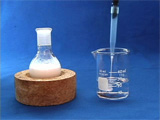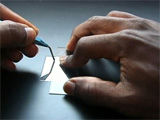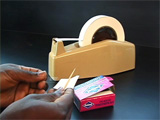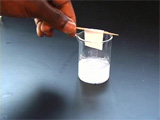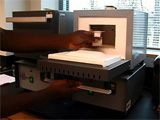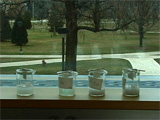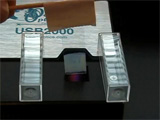
Diffraction from PMMA Nanospheres
Procedure by William Schreiter, Richard Amankwah and Karen Nordell, Chemistry Department, Lawrence University.
Evaporation of a dilute suspension of polymer nanospheres creates a close packed layer on the surface of a glass slide suspended in the solution. The particle size can be calculated from the visible absorption maximum of this colloidal crystal.
| Procedure | Wear eye protection |
To prepare a sample for SEM or optical diffraction, dilute 500 microliters of previously prepared PMMA nanosphere solution in 20 mL distilled water. Using a diamond pencil, score and break lengthwise a large glass cover slip (20 mm x 40 mm). Gently attach one of the glass pieces to a toothpick using tape. Clean the glass by soaking in isopropanol for 10 minutes followed by soaking in pure water for 5 minutes. Suspend the glass slide into the diluted PMMA nanosphere suspension you prepared earlier. If desired, more than one glass slide can be suspended in each solution as long as they do not touch each other. To promote the growth of high quality close packed layers on the glass slide, evaporate the solution in a controlled temperature environment such as an oven. If an oven is not available, the solutions can be placed in a room temperature location where they will be undisturbed such as a window sill. Under these conditions, evaporation takes between 5 and 7 days. After the solution has evaporated, a dry film of the close-packed nanospheres remains on the glass slide.
Observe the color of the film under reflected light conditions by holding the slide under a bright light source. Observe the color of light transmitted through the film by holding the glass slide up and looking at a bright light source through the slide. How are the colors of reflected and transmitted light related? Obtain the visible absorption or transmission spectrum when the glass slide is perpendicular to the beam.
Use a modified Bragg equation to calculate the size of the nanoparticles:
λp = 1.633 Ds [ns2
f + nv2 (1-f)]1/2
λp = the wavelength at maximum absorbance (in nm)
Ds = the diameter of the close packed spheres (in nm)
ns = the index of refraction for the spheres
nv = the index of refraction for the void spaces (presumably air in a dry film)
f = the filling fraction for a close packed structure (0.76)
Use a diamond pencil to score and then break off a small portion of the diffracted cover glass.
Gold coat and examine by SEM with 10,000x. Are the spheres close-packed? What size are the spheres? Does this size agree with your diffraction results?
λp = the wavelength at maximum absorbance (in nm)
Ds = the diameter of the close packed spheres (in nm)
ns = the index of refraction for the spheres
nv = the index of refraction for the void spaces (presumably air in a dry film)
f = the filling fraction for a close packed structure (0.76)
- PMMA nanospheres
- 30 or 50 mL beaker
- microscope cover slips, 20x40mm, Corning 2940-224
- diamond tip pencil
- toothpicks, tape
- isopropanol, water
- oven
- visible spectrometer
Developed in collaboration with the
University of Wisconsin Materials Research Science and Engineering Center
Interdisciplinary Education Group | MRSEC on Nanostructured Interfaces
This page created by George Lisensky, Beloit College. Last modified April 21, 2014 .
University of Wisconsin Materials Research Science and Engineering Center
Interdisciplinary Education Group | MRSEC on Nanostructured Interfaces
This page created by George Lisensky, Beloit College. Last modified April 21, 2014 .
